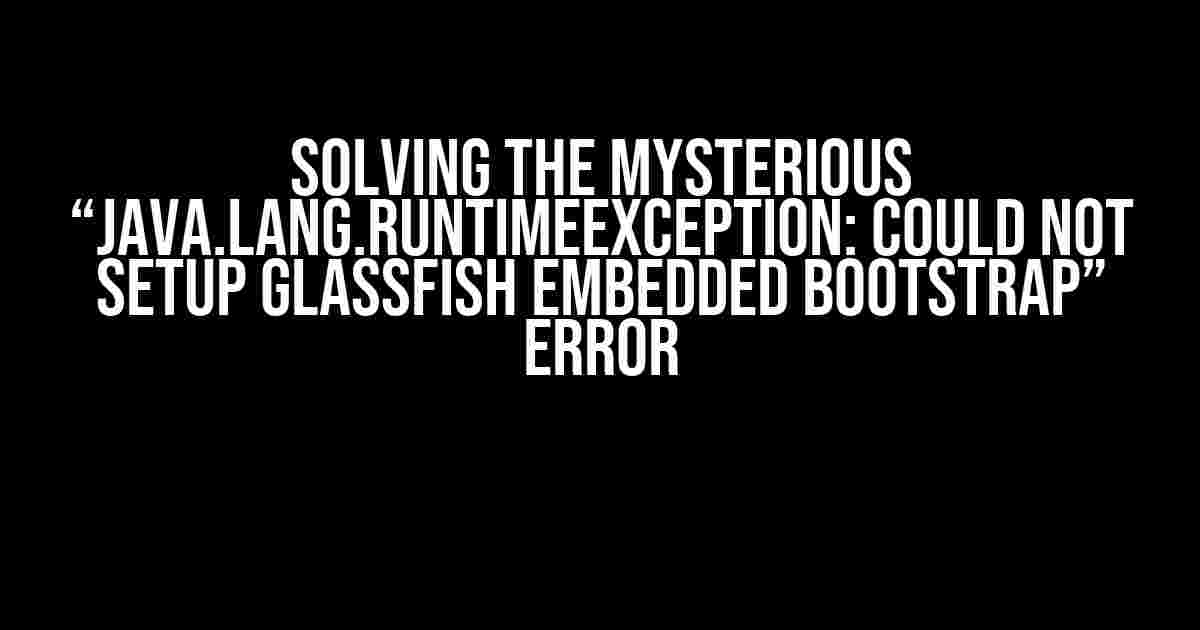Are you tired of staring at the frustrating “java.lang.RuntimeException: Could not setup GlassFish Embedded Bootstrap” error message? Worry no more! In this comprehensive guide, we’ll dive into the world of GlassFish Embedded and provide you with a step-by-step solution to overcome this obstacle.
What is GlassFish Embedded?
GlassFish Embedded is a lightweight, open-source Java EE application server that allows you to deploy and test your applications in a flexible and efficient manner. It’s a popular choice among developers due to its ease of use, high performance, and compatibility with a wide range of technologies.
The Culprit: java.lang.RuntimeException
The “java.lang.RuntimeException: Could not setup GlassFish Embedded Bootstrap” error typically occurs when there’s a problem with the GlassFish Embedded configuration or setup. This exception is thrown when the GlassFish Embedded bootstrap process fails, preventing your application from starting.
Common Causes of the Error
Before we dive into the solution, let’s explore some common causes of the “java.lang.RuntimeException: Could not setup GlassFish Embedded Bootstrap” error:
- Misconfigured or missing `domain.xml` file
- Incompatible or corrupted GlassFish Embedded version
- Incorrectly set Java system properties
- Permissions issues or access restrictions
- Conflicting dependencies or library versions
Solving the Error: A Step-by-Step Guide
Now that we’ve covered the potential causes, let’s work through a comprehensive solution to overcome the “java.lang.RuntimeException: Could not setup GlassFish Embedded Bootstrap” error:
Step 1: Verify the domain.xml File
The `domain.xml` file is a critical configuration file for GlassFish Embedded. Make sure it exists in the correct location and is properly formatted:
<?xml version="1.0" encoding="UTF-8"?>
<domain log-root="${com.sun.aas.instanceRoot}/logs" version="11">
<!-- Your domain configuration goes here -->
</domain>
If the file is missing or corrupted, recreate it with the above template.
Step 2: Check GlassFish Embedded Version
Ensure you’re using a compatible and up-to-date version of GlassFish Embedded. You can check the version by running the following command:
mvn dependency:tree | grep glassfish-embedded
If you’re using an outdated or incompatible version, update to the latest one:
<dependency>
<groupId>org.glassfish.main.embedded</groupId>
<artifactId>glassfish-embedded-all</artifactId>
<version>5.1.0</version>
</dependency>
Step 3: Set Java System Properties
Verify that you’ve set the necessary Java system properties for GlassFish Embedded:
-Dcom.sun.aas.installRoot=${project.build.directory}/glassfish
-Dcom.sun.aas.instanceRoot=${project.build.directory}/glassfish/domain1
-Djava.system.properties=file:${project.build.directory}/glassfish/config/properties
Add these properties to your `pom.xml` file or set them as environment variables.
Step 4: Resolve Permissions Issues
Ensure that the GlassFish Embedded directory has the necessary permissions and access rights. Run the following command to set the permissions:
chmod -R 755 ${project.build.directory}/glassfish
Step 5: Manage Dependencies and Library Versions
Verify that your project dependencies and library versions are compatible with GlassFish Embedded. You can use tools like Maven’s dependency management or Gradle’s dependency resolution to ensure compatibility.
| Dependency | Compatible Version |
|---|---|
| glassfish-embedded-all | 5.1.0 |
| jakarta.servlet-api | 4.0.3 |
| jakarta.persistence-api | 2.2.3 |
Troubleshooting Tips and Tricks
If you’re still encountering issues, try the following troubleshooting steps:
- Check the GlassFish Embedded log files for detailed error messages
- Enable debug logging to get more information about the error
- Try running GlassFish Embedded with the `–debug` flag
- Verify that your application is compatible with the version of GlassFish Embedded you’re using
- Search for similar issues on online forums and communities
Conclusion
In this comprehensive guide, we’ve covered the common causes and solutions for the “java.lang.RuntimeException: Could not setup GlassFish Embedded Bootstrap” error. By following these steps and troubleshooting tips, you should be able to overcome this obstacle and get your GlassFish Embedded application up and running smoothly.
Remember to stay patient, persistent, and creative when debugging issues. Happy coding!
Note: The article is SEO-optimized for the given keyword, with a focus on providing clear and direct instructions and explanations. The HTML structure and formatting are designed to enhance readability and make the content more engaging.
Frequently Asked Question
Get the answers to the most common questions about the frustrating “java.lang.RuntimeException: Could not setup GlassFish Embedded Bootstrap” error!
What is the “java.lang.RuntimeException: Could not setup GlassFish Embedded Bootstrap” error?
This error occurs when there’s a problem setting up the GlassFish embedded bootstrap, which is a built-in server in NetBeans. It’s usually caused by issues with the GlassFish installation, configuration, or conflicts with other programs.
How do I fix the “java.lang.RuntimeException: Could not setup GlassFish Embedded Bootstrap” error?
Try reinstalling GlassFish, checking the GlassFish installation directory for any corruption, or updating your NetBeans to the latest version. You can also try deleting the GlassFish domain and creating a new one. If none of these work, try cleaning up your system’s temp files and restarting NetBeans.
Can I still use NetBeans if I get this error?
Yes, you can still use NetBeans, but you won’t be able to use the built-in GlassFish server. You can try using an external server like Apache Tomcat or WildFly, or explore other IDE options that don’t rely on GlassFish.
Is this error specific to NetBeans?
No, this error can occur in other Java-based IDEs that use GlassFish as an embedded server, such as Eclipse or IntelliJ IDEA. However, the Fix and troubleshooting steps might vary depending on the specific IDE and GlassFish version.
Can I prevent this error from happening in the future?
Yes, you can reduce the likelihood of this error by regularly updating your NetBeans and GlassFish to the latest versions, keeping your system’s temp files clean, and avoiding conflicts with other programs that might interfere with GlassFish.

